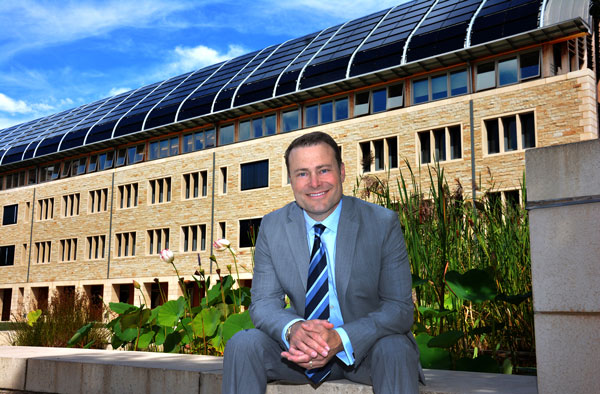When you enter any green-built home or commercial building, with just a cursory glance, you might notice the double-paned windows, the motion sensing lighting arrays, or even the reclaimed wood floors beneath your feet. But you’re unlikely to have considered the most important threshold—the point of access and exit, the place that blurs the line of within and without—the door opening you just passed through.
Doorways trade gulps of air with the outside environment, making them essential to the health impact of a building. Understanding how someone can access a structure—and controlling what they bring in and what they leave behind—is essential to a building’s ecosystem. And while designers and builders have taken great, industry-wide strides toward eco-friendly practices, the environmental impact of entrances and exits is widely under-examined. Enter Aaron Smith, director of sustainable building solutions for ASSA ABLOY Door Security Solutions. It is his passion (and his job) to raise awareness of the importance of doorways and locking systems in sustainable building practices. For Smith, the job begins at home, as he leads ASSA ABLOY’s efforts to optimize and implement sustainable manufacturing and distribution systems—not only to create more environmentally friendly products, but also to serve as an example for the company’s suppliers and competitors.
Smith was born and raised in Minneapolis, Minnesota, where his father was a factory worker. As an adult, Smith entered the building materials industry bearing a deep and abiding pride in the history and traditions of American manufacturing. In the mid-1990s, at the same time that he was starting his career, the US Green Building Council began releasing its rating system. Smith was on the frontlines as attitudes toward sustainable design shifted and a new consciousness dawned, both within his industry and the public’s desire for healthier homes and workplaces. “I just fell in love with it,” Smith says, “What a great concept that our buildings could be green, energy efficient and healthy.” Thus, he became a LEED-accredited professional, and a career was born.
In 2010, Swedish-owned lock manufacturer ASSA ABLOY reached out to Smith to run their sustainability programs. He was mutually drawn to the company based on their corporate culture and dedication to industry innovation. But what sealed the deal was closer to Smith’s heart, “[ASSA ABLOY] has 28 factories in North America, and I’ve always been very proud that we are a company manufacturing products in the United States.”
ASSA ABLOY is the world’s largest manufacturer of door opening solutions and has appropriately complex operations that span manufacturing, distribution, product testing, sales, and installation. During his time with the company, Smith has helped conceive and enact enterprise-wide initiatives to make ASSA ABLOY more environmentally friendly. “We already had good programs in place, but what we’ve been focused on is really driving sustainable concepts into the fabric of our culture and to really engage our employees,” comments Smith. “You can have a “top-down” edict, but its more fun when it starts to come “bottom-up” and you start to get great ideas from employees, partners, and customers.”
Smith is happy to discuss the progress ASSA ABLOY has made on the manufacturing side, with several plants working toward zero waste-to-landfill. One recent project resulted in the installation of a 1.1-megawatt solar array at an ASSA ABLOY factory in Connecticut, providing 20% of the plant’s power. “We’ve been making locks in Connecticut for 150 years, so it’s really cool to be using an old line manufacturing plant that is green across its operations.” Efforts like this can perhaps secure the company’s presence and lessen the environment impact in the region for another 150 years.

The company’s 1.1-megawatt solar array at a factory in Connecticut provides 20% of the plant’s power.
One initiative close to Smith’s heart is the leadership role ASSA ABLOY has taken with Health Product Declarations (HPDs) and the influence the company can have on their suppliers. “I was the only manufacturing representative on the board of the Health Product Declaration Collaborative,” he recalls. “In 2011, I was asked whether we would disclose the ingredients of our products, and because our mission as a company is to protect people and buildings, it felt like a natural parallel to have materials that protect people and places.” ASSA ABLOY became one of the first manufacturers to participate and now has 150 HPDs and EPDs across all product categories. “We want to lead the transformation of our market sector; others will come along, but we are ready to lead.” The company has also developed a “Red List” of hazardous materials and works actively to audit and educate their 800+ suppliers in an effort to remove the materials from the supply chain.
HPDs and EPDs are focused on educating consumers about the impact of the products they purchase and use, but as Smith and ASSA ABLOY learned, companies participating often learn unexpected things about their own products. “When we performed a lifecycle assessment of an electronic access control system, we discovered that the majority of our impact was from energy use, so we developed ultra-low energy consumption access control projects,” Smith says. “The EPD process really taught us where to focus and starts a sort of virtuous process of product innovation.”
Smith’s goal with ASSA ABLOY is to flip the paradigm regarding sustainable and green products. While the focus on transparency engendered by HPDs and EPDs is essential, Smith imagines a future where products are assumed to be eco-friendly, and products that aren’t safe are labeled. “If we are successful, and we have a long way to go,” he concludes. “Every product we come out with will have sustainability embedded into it, made of the healthiest, most environmentally-friendly materials.”

